1970-79 From its foundation to its manufacturer transformation
It first started doing contract work in design, repair and cleaning of waterworks installations, among others. Then, in response to a request, the Mini-Power was developed and marketed.

The Mini-Power in operation
In the early 1970′s, a restraint fitting for Push-On Joint (Tyton) pipe bends, the Ty-Holder was developed and its polarization started. Because of its wedge structure (the structure is such that it uses the pulling force to get a firmer grip), it boasted a superior restraining performance and a bending moment retention feature. It is also easy to use. At the time, concrete blocks were widely used to prevent separation of the Push-On Joint (Tyton) pipe bends.

In 1974, during the 8th Waterworks Exhibition in Otsu city, the Ty-Holder was exhibited.
In 1976, the wedge restraining structure was rapidly growing in popularity, more than the mainstream push on bolt method; thus, the retainer gland (Mecha-Holder) with an enhanced wedge structure was developed. Today, the wedge structure which uses the pulling force to get a better grip has become the mainstream successor restraint fitting.
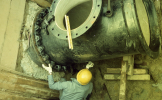
A site of an installation of a Mecha-Holder
1980-89 First license agreement and exportation
In 1980, the initial SUPER FLEX model was developed and marketed. The initial model had the deflection, expansion and contraction mechanism integrated inside the ball part. Although at the time, expansion joints made of rubber and steel were used as the standard in ductile iron pipelines; a flexible expansion joint made of ductile cast iron and structurally capable of rotation, deflection, expansion and contraction was desired to be connected to the pipeline having the same material quality and rigidity.
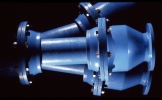
The first model of SUPER FLEX
In 1983, the first license agreement for the Ty-Holder and the Mecha-Holder was granted to Canron, a Canadian company.
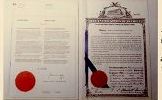
CANADA, USA Patent “DEVICE FOR CONNECTING TELESCOPING PIPES”
In 1986, SUPER FLEX was improved and released to the market, making the ductile cast iron flexible expansion joint grow in popularity. It was structurally improved by assembling two overlapped pipes in the middle connected to both ball parts at the ends. Because of this improvement, it reasonably absorbs the complex displacements caused by bending, expanding, contracting and twisting in the pipelines. Due to its ideal new shape, the inside shape of the pipe won’t change when deflections occur. Also, since an expandable part can be attached and added, both the amount of deflection and expansion are increased; thus, making possible and flexible an installation with the performance of the flexible expansion joint according to the location at hand.
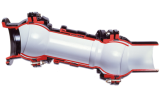
SUPER FLEX, The inner structure and surface of flexible part is improved in the shape of a ball
1990-99 SUPER FLEX demonstrates its quake absorbing performance at different earthquake locations
In the middle of the 1980’s, through the license given to EBAA Iron, SUPER FLEX spread throughout the west coast of the United States. Furthermore, its quake absorbing performance was substantiated in Oct. of 1989 during the Loma Prieta Earthquake (San Francisco Earthquake), and in January of 1994 during the Northridge Earthquake (Los Angeles Earthquake). In Japan where there were about 300 SUPER FLEX installed, not a single damage was reported during the Hanshin-Awaji (Kobe) Earthquake in January of 1995. Once again demonstrating its quake absorbing performance.
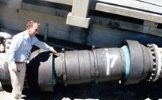
Loma Prieta Earthquake, SUPER FLEX deflected
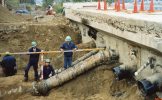
Hanshin-Awaji Earthquake, SUPER FLEX at work
Subsided 1,100mm and expanded 170mm

In 1999, it was improved again to its current structure without bolts at the ball parts
In 1994, the importation and domestic sales of the All Fits Joint from Holland, Georg Fischer WAGA started. Today’s popular coupling joint model for all kinds of pipe material’s connections have gone through numerous alterations since its origin.
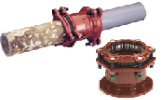
Initially, it was only a dresser coupling (top picture) and by adjusting to the needs the line of products increased to today’s coupling with a flange among others (picture below)
2000-09 Expanding into the field of under pressure installations
Up to now, the main stream method of installing a valve without disrupting the water service used a drilling machine with a hole saw to cut away a circular shaped piece from the top part of the existing pipeline and then inserting a cylinder shaped elastic body to temporarily stop the water flow. This was called the method of Line Stopping, Stopper. The otherwise method called Valve Insertion, cut off the entire pipe and installed a valve.
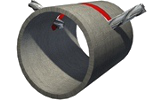
Image of End Mill drilling
In 1999, Suiken’s new development and ground-breaking EM Under Pressure Installation System uses an end mill drilling machine to drill a slot on the existing pipeline and then insert a low torque soft seal valve in the aperture of the pipe; thus, making a waterproof seal in the pipe. Compared to the conventional method, the drilling machine and surrounding equipments needed to make an installation got smaller.
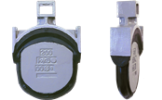
S-GATE’s soft seal valve gate
In 2005, a license agreement of the EM Under Pressure Installation System was given to Advanced Valve Technologies in the United States and in 2006 to Daepoong Construction Co., in Korea. The EM Under Pressure Installation System superiority and uniqueness was recognized both in the United States and Korea; thus, steadily increasing its sales record.
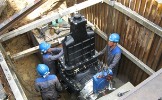
500mm S-GATE installation in Yamaguchi Prefecture, Hikari City
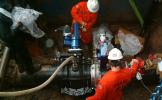
16 Inch S-GATE installation in New York State, U.S.A.
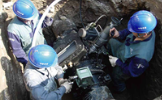
350mm S-GATE installation in Naju City, Korea
2010-present Promoting product development focused on the world market
In 2011, the under pressure installation system for size 50mm S-GATE MN was developed. Its simple and stream line design is the result of accumulated and cultured experience from S-GATE. It features a smooth opening and closing operation and a low torque water seal. Emphasis put on performance, it has a compact body and its drilling machine minimizes the load on the existing pipe line; thus, making a safe installation possible.
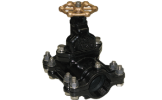
S-GATE MN
The PE Bender, a universal fitting for connections between polyethylene pipe and ductile iron pipe and a flexible expansion joint SUPER FLEX for connections between polyethylene pipe and ductile iron was developed. Due to the original assembly technology, commercialization of the flexible expansion joint and universal fitting with polyethylene pipe spigots was realized. This line of products further contributes to the extension of the life span of the pipeline by decreasing the burden and local displacements on polyethylene pipelines.
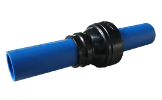
PE Bender
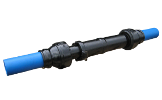
SUPER FLEX with polyethylene spigots
